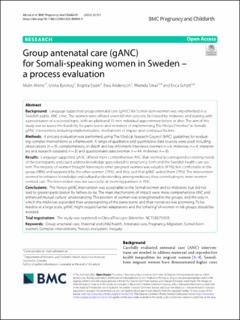| dc.description.abstract | Background
Language supported group antenatal care (gANC) for Somali-born women was implemented in a Swedish public ANC clinic. The women were offered seven 60-min sessions, facilitated by midwives and starting with a presentation of a selected topic, with an additional 15-min individual appointment before or after. The aim of this study was to assess the feasibility for participants and midwives of implementing The Hooyo (“mother” in Somali) gANC intervention, including implementation, mechanisms of impact and contextual factors.
Methods
A process evaluation was performed, using The Medical Research Council (MRC) guidelines for evaluating complex interventions as a framework. A range of qualitative and quantitative data sources were used including observations (n = 9), complementary, in-depth and key-informant interviews (women n = 6, midwives n = 4, interpreters and research assistants n = 3) and questionnaire data (women n = 44; midwives n = 8).
Results
Language-supported gANC offered more comprehensive ANC that seemed to correspond to existing needs of the participants and could address knowledge gaps related to pregnancy, birth and the Swedish health care system. The majority of women thought listening to other pregnant women was valuable (91%), felt comfortable in the group (98%) and supported by the other women (79%), and they said that gANC suited them (79%). The intervention seemed to enhance knowledge and cultural understanding among midwives, thus contributing to more women-centred care. The intervention was not successful at involving partners in ANC.
Conclusions
The Hooyo gANC intervention was acceptable to the Somali women and to midwives, but did not lead to greater participation by fathers-to-be. The main mechanisms of impact were more comprehensive ANC and enhanced mutual cultural understanding. The position of women was strengthened in the groups, and the way in which the midwives expanded their understanding of the participants and their narratives was promising. To be feasible at a large scale, gANC might require further adaptations and the “othering” of women in risk groups should be avoided. | en_US |

